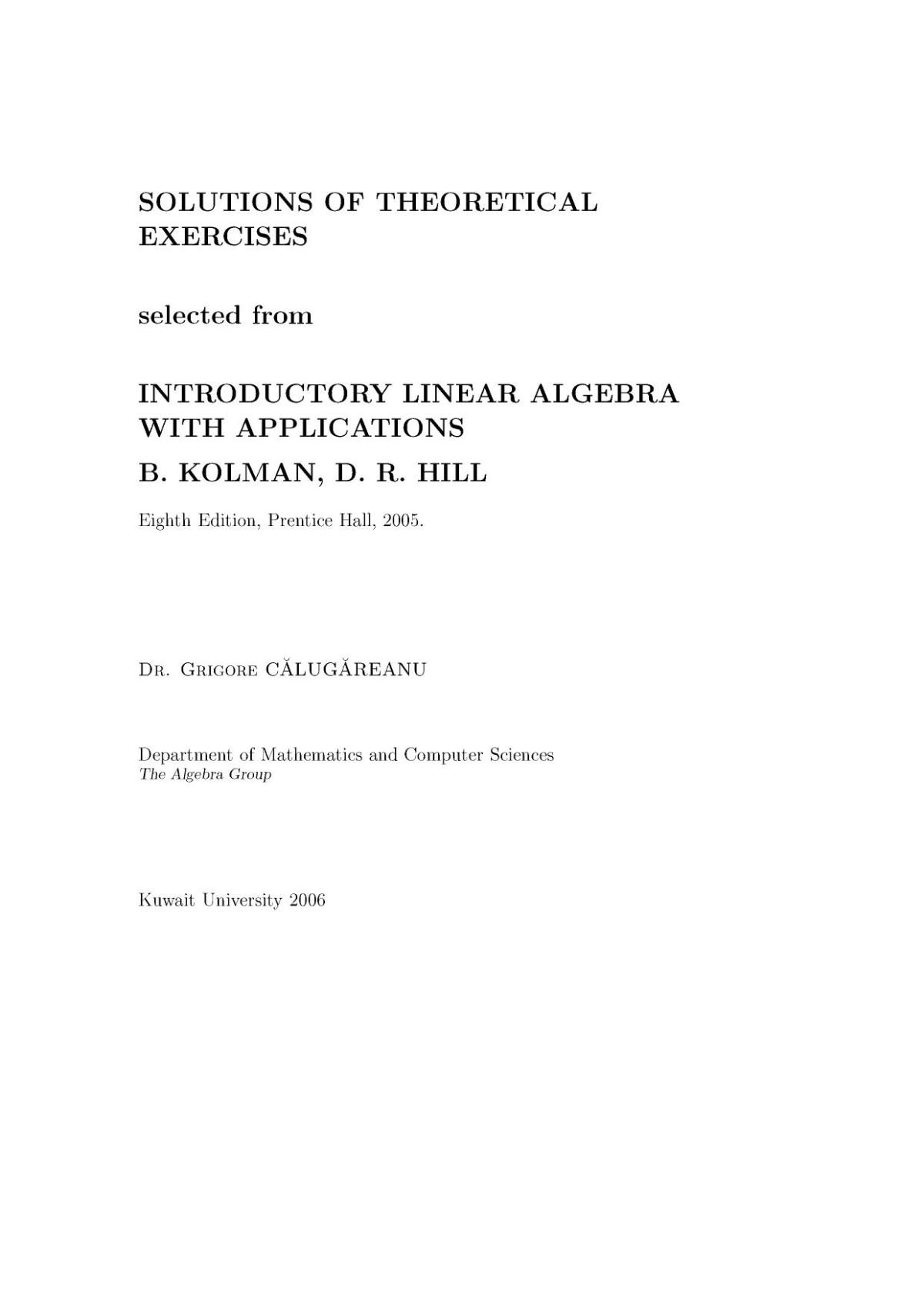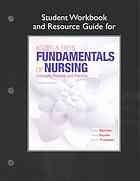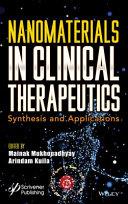ElementaryLinear Algebrawith Applications
NinthEdition
BernardKolman
DrexelUniversity
DavidR.Hill
TempleUniversity
EditorialDirector,ComputerScience,Engineering,andAdvancedMathematics: MarciaJ.Horton
SeniorEditor: HollyStark
EditorialAssistant: JenniferLonschein
SeniorManagingEditor/ProductionEditor: ScottDisanno
ArtDirector: JuanL´opez
CoverDesigner: MichaelFruhbeis
ArtEditor: ThomasBenfatti
ManufacturingBuyer: LisaMcDowell
MarketingManager: TimGalligan
CoverImage:(c) WilliamT.Williams,Artist,1969Trane,1969Acryliconcanvas, 108 × 84 CollectionofTheStudioMuseuminHarlem.GiftofCharlesCowles,NewYork.
c 2008,2004,2000,1996byPearsonEducation,Inc. PearsonEducation,Inc.
UpperSaddleRiver,NewJersey07458
Earliereditions c 1991,1986,1982,byKTI; 1977,1970byBernardKolman
Allrightsreserved.Nopartofthisbookmaybereproduced,inanyformorbyanymeans,withoutpermissionin writingfromthepublisher.
PrintedintheUnitedStatesofAmerica 10987654321
ISBN0-13-229655-1
PearsonEducation,Ltd., London
PearsonEducationAustraliaPTY.Limited, Sydney
PearsonEducationSingapore,Pte.,Ltd
PearsonEducationNorthAsiaLtd, HongKong
PearsonEducationCanada,Ltd., Toronto
PearsonEducaci´ondeMexico,S.A.deC.V.
PearsonEducation—Japan, Tokyo
PearsonEducationMalaysia,Pte.Ltd
1.8CorrelationCoe
3.1Definition...............................................37
5InnerProductSpaces 71
5.1StandardInnerProducton R2 and R3 ...............................71
5.2CrossProductin R3 (Optional)...................................74
5.3InnerProductSpaces.........................................77
5.4Gram-SchmidtProcess........................................81
5.5OrthogonalComplements......................................84
5.6LeastSquares(Optional)......................................85 SupplementaryExercises.......................................86 ChapterReview............................................90
6LinearTransformationsandMatrices93
6.1DefinitionandExamples.......................................93
6.2KernelandRangeofaLinearTransformation...........................96
6.3MatrixofaLinearTransformation.................................97
6.4VectorSpaceofMatricesandVectorSpaceofLinearTransformations(Optional).......99
6.5Similarity...............................................102
6.6IntroductiontoHomogeneousCoordinates(Optional)......................103 SupplementaryExercises.......................................105 ChapterReview............................................106
7EigenvaluesandEigenvectors109
7.1EigenvaluesandEigenvectors....................................109
7.2DiagonalizationandSimilarMatrices................................115
7.3DiagonalizationofSymmetricMatrices...............................120 SupplementaryExercises.......................................123 ChapterReview............................................126
8ApplicationsofEigenvaluesandEigenvectors(Optional)129
8.1StableAgeDistributioninaPopulation;MarkovProcesses...................129
8.2SpectralDecompositionandSingularValueDecomposition...................130
8.3DominantEigenvalueandPrincipalComponentAnalysis....................130
8.4DifferentialEquations........................................131
8.5DynamicalSystems..........................................132
8.6RealQuadraticForms........................................133
8.7ConicSections............................................134
8.8QuadricSurfaces...........................................135
10MATLABExercises 137
AppendixBComplexNumbers163
B.1ComplexNumbers..........................................163
B.2ComplexNumbersinLinearAlgebra................................165
Preface
ThismanualistoaccompanytheNinthEditionofBernardKolmanandDavidR.Hill’s ElementaryLinear AlgebrawithApplications .Answerstoallevennumberedexercisesanddetailedsolutionstoalltheoretical exercisesareincluded.ItwaspreparedbyDennisKletzing,StetsonUniversity.Itcontainsmanyofthe solutionsfoundintheEighthEdition,aswellassolutionstonewexercisesincludedintheNinthEditionof thetext.
LinearEquationsandMatrices
Section1.1,p.8
2. x =1, y =2, z = 2. 4.Nosolution.
6. x =13+10t, y = 8 8t, t anyrealnumber.
8.Inconsistent;nosolution.
10. x =2, y = 1. 12.Nosolution.
14. x = 1, y =2, z = 2.
16.(a)Forexample: s =0, t =0isoneanswer. (b)Forexample: s =3, t =4isoneanswer. (c) s = t 2 .
18.Yes.Thetrivialsolutionisalwaysasolutiontoahomogeneoussystem.
20. x =1, y =1, z =4.
22. r = 3.
24.If x1 = s1 , x2 = s2 , ... , xn = sn satisfyeachequationof(2)intheoriginalorder,thenthose samenumberssatisfyeachequationof(2)whentheequationsarelistedwithoneoftheoriginalones interchanged,andconversely.
25.If x1 = s1 , x2 = s2 , ... , xn = sn isasolutionto(2),thenthe pthand q thequationsaresatisfied. Thatis,
Thus,foranyrealnumber r ,
Thenifthe q thequationin(2)isreplacedbytheprecedingequation,thevalues x1 = s1 , x2 = s2 , , xn = sn areasolutiontothenewlinearsystemsincetheysatisfyeachoftheequations.
26.(a)Auniquepoint.
(b)Thereareinfinitelymanypoints.
(c)Nopointssimultaneouslylieinallthreeplanes.
28.Nopointsofintersection:
Onepointofintersection:
Twopointsofintersection:
Infinitelymanypointsofintersection:
30.20tonsoflow-sulfurfuel,20tonsofhigh-sulfurfuel.
32.3.2ouncesoffoodA,4.2ouncesoffoodB,and2ouncesoffoodC.
34.(a)
Section1.2,p.19
2.(a) A =
10.Yes:2
14.Becausetheedgescanbetraversedineitherdirection.
16.Let
20.“newsalaries”=
Section1.3,p.30
2.(a)4.(b)0.(c)1.(d)1.
4. x =5.
6. x = ±√2, y = ±3.
8. x = ±5.
10. x = 6 5 , y = 12 5 .
12.(a)Impossible.(b) 0 11 12517 19022
.(c)
15 714 23 529 13 117
14.(a) 5812 6613 .(b)Sameas(a).(c) 28838 34441
(d)Sameas(c).(e) 2832 1618 ;same.(f) 16 8 26 300 31
16.(a)1.(b) 6.(c) 301 .(d) 142 284 3 12 6
.(e)10. (f)
90 3 000 301
.(g)Impossible.
18. DI2 = I2 D = D
20. 00 00
22.(a)
.(e)Impossible.
24.col1 (AB )=1
26.(a) 5.(b) BAT
28.Let A = aij be m × p and B = bij be p × n.
(a)Letthe ithrowof A consistentirelyofzeros,sothat aik =0for k =1, 2,...,p.Thenthe(i,j ) entryin AB is
(b)Letthe j thcolumnof A consistentirelyofzeros,sothat akj =0for k =1, 2,...,m.Thenthe (i,j )entryin BA is
30.(a)
32. 23 1 5 x1 x2 = 5 4
34.(a)
36.(a) x
38.(a)
39.Wehave
(b)sameas(a).
40.Possibleanswer:
42.(a)Cansaynothing.(b)Cansaynothing.
43.(a)Tr(cA)= n i=1 caii = c n i=1 aii = c Tr(A).
(b)Tr(A + B )=
(c)Let AB = C = cij .Then
(d)Since aT ii = aii ,Tr(AT )= n i=1 a T ii = n i=1 aii =Tr(A).
(e)Let AT A = B = bij .Then
Hence,Tr(AT A) ≥ 0.
44.(a)4.(b)1.(c)3.
45.WehaveTr(AB BA)=Tr(AB ) Tr(BA)=0,whileTr 10 01 =2.
46.(a)Let A = aij and B = bij be m × n and n × p,respectively.Then b
entryof Abj is n k =1 aik bkj ,whichisexactlythe(i,j )entryof AB
(b)The ithrowof AB is k aik
wehave
Thisisthesameasthe ithrowof Ab
.Since
andthe ith
47.Let A = aij and B = bij be m × n and n × p,respectively.Thenthe j thcolumnof AB is (AB )j =
= b1j Col1 (A)+ + bnj Coln (A)
Thusthe j thcolumnof AB isalinearcombinationofthecolumnsof A withcoefficientstheentriesin bj
48.Thevalueoftheinventoryofthefourtypesofitems.
50.(a)row 1 (A) col1 (B )=80(20)+120(10)=2800gramsofproteinconsumeddailybythemales. (b)row 2 (A) col2 (B )=100(20)+200(20)=6000gramsoffatconsumeddailybythefemales.
51.(a)No.If x =(x1 ,x2 ,...,xn ),then x · x = x2 1 + x2 2 + + x2 n ≥ 0. (b) x = 0
52.Let a =(a1 ,a2 ,...,an ), b =(b1 ,b2 ,...,bn ),and c =(c1 ,c2 ,...,cn ).Then (a) a · b = n i=1 ai bi and b · a = n i=1 bi ai ,so a · b = b · a (b)(a + b) · c = n i=1 (ai + bi )ci = n i=1 ai ci + n i=1 bi ci = a · c + b · c (c)(k a) · b = n i=1 (kai )bi = k n i=1 ai bi = k (a · b).
53.The i, ithelementofthematrix AAT is n k =1 aik a T ki = n k =1 aik aik = n k =1 (aik )2
Thusif AAT = O ,theneachsumofsquares n k =1 (aik )2 equalszero,whichimplies aik =0foreach i and k .Thus A = O .
54. AC = 17222 18323 CA cannotbecomputed.
55. B T B willbe6 × 6while BB T is1 × 1.
Section1.4,p.40
1.Let A = aij , B = bij , C = cij .Thenthe(i,j )entryof A +(B + C )is aij +(bij + cij )and thatof(A + B )+ C is(aij + bij )+ cij .Bytheassociativelawforadditionofrealnumbers,thesetwo entriesareequal.
2.For A = aij ,let B = aij
4.Let A = aij , B = bij , C = cij .Thenthe(i,j )entryof(A + B )C is n k =1 (aik + bik )ckj andthatof AC + BC is n k =1 aik ckj + n k =1 bik ckj .Bythedistributiveandadditiveassociativelawsforrealnumbers, thesetwoexpressionsforthe(i,j )entryareequal.
6.Let A = aij ,where aii = k and aij =0if i = j ,andlet B = bij .Then,if i = j ,the(i,j )entryof AB is n s=1 ais bsj = kbij ,whileif i = j ,the(i,i)entryof AB is n s=1 ais bsi = kbii .Therefore AB = kB
7.Let A = aij and C = c1 c2 cm .Then CA isa1 × n matrixwhose ithentryis n j =1 cj aij . Since Aj =
,the
(d)Theresultistruefor p =2and3asshowninparts(a)and(b).Assumethatitistruefor p = k . Then
Hence,itistrueforallpositiveintegers k
10.Possibleanswers: A = 10 01 ; A = 01 10 ; A =
12.Possibleanswers: A = 11 1 1 ; A = 00 00 ; A = 01 00
13.Let A = aij .The(i,j )entryof r (sA)is r (saij ),whichequals(rs)aij and s(raij ).
14.Let A = aij .The(i,j )entryof(r + s)A is(r + s)aij ,whichequals raij + saij ,the(i,j )entryof rA + sA
16.Let A = aij ,and B = bij .Then r (aij + bij )= raij + rbij .
18.Let A = aij and B = bij .The(i,j )entryof A(rB )is n k =1 aik (rbkj ),whichequals r n k =1 aik bkj ,the (i,j )entryof r (AB ).
20. 1 6 A, k = 1 6 .
22.3.
24.If Ax = r x and y = sx,then Ay = A(sx)= s(Ax)= s(r x)= r (sx)= r y
26.The(i,j )entryof(AT )T isthe(j,i)entryof AT ,whichisthe(i,j )entryof A.
27.(b)The(i,j )entryof(A + B )T isthe(j,i)entryof aij + bij ,whichistosay, aji + bji (d)Let A = aij andlet bij = aji .Thenthe(i,j )entryof(cA)T isthe(j,i)entryof caij ,which istosay, cbij
28.(A + B )T =
30.(a)
.(c) B T C isarealnumber(a1 × 1matrix).
32.Possibleanswers: A = 1 3 00 ; B = 12 2 3 1 ; C = 12 01 A = 20 30 ; B = 00 10 ; C = 00 01
33.The(i,j )entryof cA is caij ,whichis0forall i and j onlyif c =0or aij =0forall i and j
34.Let A = ab cd besuchthat AB = BA forany2 × 2matrix B .Theninparticular, ab cd 10 00 = 10 00 ab cd a 0 c 0 = ab 00 so b = c =0, A = a 0 0 d
Also a 0 0 d 11 00 = 11 00 a 0 0 d aa 00 = ad 00 , whichimpliesthat a = d.Thus A = a 0 0 a forsomenumber a
35.Wehave (A B )T =(A +( 1)B )T = AT +(( 1)B )T = AT +( 1)B T = AT B T byTheorem1.4(d)).
36.(a) A(x1 + x2 )= Ax1 + Ax2 = 0 + 0 = 0.
(b) A(x1 x2 )= Ax1 Ax2 = 0 0 = 0
(c) A(r x1 )= r (Ax1 )= r 0 = 0
(d) A(r x1 + sx2 )= r (Ax1 )+ s(Ax2 )= r 0 + s0 = 0.
37.Weverifythat x3 isalsoasolution:
38.If Ax1 = b and Ax2 = b,then A(x1 x2 )= Ax1 Ax2 = b b = 0.
Section1.5,p.52
1.(a)Let Im = dij so dij =1if i = j and0otherwise.Thenthe(i,j )entryof Im A is m k =1 dik akj = dii aij (sinceallother d’s=0) = aij (since dii =1).
2.Weprovethattheproductoftwouppertriangularmatricesisuppertriangular:Let A = aij with aij =0for i>j ;let B = bij with bij =0for i>j .Then AB = cij where cij = n k =1 aik bkj .For i>j ,andeach1 ≤ k ≤ n,either i>k (andso aik =0)orelse k ≥ i>j (so bkj =0).Thusevery terminthesumfor cij is0andso cij =0.Hence cij isuppertriangular.
3.Let A = aij and B = bij ,whereboth aij =0and bij =0if i = j .Thenif AB = C = cij ,we have cij = n k =1 aik bkj =0if i = j
4. A + B = 9 11 0 27 003 and AB = 18 511 0 8 7 000 .
5.Alldiagonalmatrices.
6.(a) 7 2 310 (b) 9 11 2213 (c) 20 20 476
8. Ap Aq =(A A A) p factors (A A A) q factors p + q factors = Ap+q ;(Ap )q = Ap Ap Ap Ap q factors = A q summands p + p + ··· + p = Apq .
9.Wearegiventhat AB = BA.For p =2,(AB )2 =(AB )(AB )= A(BA)B = A(AB )B = A2 B 2
Assumethatfor p = k ,(AB )k = Ak B k .Then (AB )k +1 =(AB )k (AB )= Ak B k A B = Ak (B k 1 AB )B = Ak (B k 2 AB 2 )B = = Ak +1 B k +1 .
Thustheresultistruefor p = k +1.Henceitistrueforallpositiveintegers p.For p =0,(AB )0 = In = A0 B 0
10.For p =0,(cA)0 = In =1 In = c0 A0 .For p =1, cA = cA.Assumetheresultistruefor p = k : (cA)k = ck Ak ,thenfor k +1:
(cA)k +1 =(cA)k (cA)= c k Ak cA = c k (Ak c)A = c k (cAk )A =(c k c)(Ak A)= c k +1 Ak +1 .
11.Truefor p =0:(AT )0 = In = I T n =(A0 )T .Assumetruefor p = n.Then (AT )n+1 =(AT )n AT =(An )T AT =(AAn )T =(An+1 )T
12.Truefor p =0:(A0 ) 1 = I 1 n = In .Assumetruefor p = n.Then (An+1 ) 1 =(An A) 1 = A 1 (An ) 1 = A 1 (A 1 )n =(A 1 )n+1 .
13. 1 k A 1 (kA)= 1 k k A 1 A = In and(kA) 1 k A 1 = k 1 k AA 1 = In .Hence,(kA) 1 = 1 k A 1 for k =0.
14.(a)Let A = kIn .Then AT =(kIn )T = kI T n = kIn = A
(b)If k =0,then A = kIn =0In = O ,whichissingular.If k =0,then A 1 =(kA) 1 = 1 k A 1 ,so A isnonsingular.
(c)No,theentriesonthemaindiagonaldonothavetobethesame.
16.Possibleanswers: ab 0 a .Infinitelymany.
17.Theresultisfalse.Let A = 12 34 .Then AAT = 511 1125 and AT A = 1014 1420
18.(a) A issymmetricifandonlyif AT = A,orifandonlyif aij = aT ij = aji
(b) A isskewsymmetricifandonlyif AT = A,orifandonlyif aT ij = aji = aij
(c) aii = aii ,so aii =0.
19.Since A issymmetric, AT = A andso(AT )T = AT
20.Thezeromatrix.
21.(AAT )T =(AT )T AT = AAT
22.(a)(A + AT )T = AT +(AT )T = AT + A = A + AT
(b)(A AT )T = AT (AT )T = AT A = (A AT ).
23.(Ak )T =(AT )k = Ak .
24.(a)(A + B )T = AT + B T = A + B
(b)If AB issymmetric,then(AB )T = AB ,but(AB )T = B T AT = BA,so AB = BA.Conversely,if AB = BA,then(AB )T = B T AT = BA = AB ,so AB issymmetric.
25.(a)Let A = aij beuppertriangular,sothat aij =0for i>j .Since AT = aT ij ,where aT ij = aji , wehave aT ij =0for j>i,or aT ij =0for i<j .Hence AT islowertriangular. (b)Proofissimilartothatfor(a).
26.Skewsymmetric.Toshowthis,let A beaskewsymmetricmatrix.Then AT = A.Therefore (AT )T = A = AT .Hence AT isskewsymmetric.
27.If A isskewsymmetric, AT = A.Thus aii = aii ,so aii =0.
28.Supposethat A isskewsymmetric,so AT = A.Then(Ak )T =(AT )k =( A)k = Ak if k isa positiveoddinteger,so Ak isskewsymmetric.
29.Let S = 1 2 (A + AT )and K = 1 2 (A AT ).Then S issymmetricand K isskewsymmetric,by Exercise18.Thus S + K = 1 2 (A + AT + A AT )= 1 2 (2A)= A. Conversely,suppose A = S + K isanydecompositionof A intothesumofasymmetricandskew symmetricmatrix.Then AT =(S + K )
30. S = 1 2
31.Form 23 46 wx yz = 10 01 .Sincethelinearsystems
havenosolutions,weconcludethatthegivenmatrixissingular.
32. D 1 =
38. 9 6 .
40. 8 9 .
42.Possibleanswer: 10 00 + 00 01 = 10 01
43.Possibleanswer: 12 34 + 1 2 34 = 00 68
44.Theconclusionofthecorollaryistruefor r =2,byTheorem1.6.Suppose r ≥ 3andthatthe conclusionistrueforasequenceof r 1matrices.Then
45.Wehave A 1 A = In = AA 1 andsinceinversesareunique,weconcludethat(A 1 ) 1 = A
46.Assumethat A isnonsingular,sothatthereexistsan n × n matrix B suchthat AB = In .Exercise28 inSection1.3impliesthat AB hasarowconsistingentirelyofzeros.Hence,wecannothave AB = In
47.Let
50.Multiplybothsidesoftheequationby
51.Multiplybothsidesby A 1
52.Form ab cd wx yz = 10 01 .Thisleadstothelinearsystems
aw + by =1 cw + dy =0 and ax + bz =0 cx + dz =1.
Asolutiontothesesystemsexistsonlyif ad bc =0.Conversely,if ad bc =0thenasolutionto theselinearsystemsexistsandwefind A 1
53. Ax = 0 impliesthat A 1 (Ax)= A0 = 0,so x = 0
54.Wemustshowthat(A 1 )T = A 1 .First, AA 1 = In impliesthat(AA 1 )T = I T n = In .Now (AA 1 )T =(A 1 )T AT =(A 1 )T A,whichmeansthat(A 1 )T = A 1
55. A + B = 45 0 04 1 6 2 6 isonepossibleanswer.
56. A =
and B =
AB =
2148414840 182634335 2426424716 2838547035 3333567442 3437587954
57.Asymmetricmatrix.Toshowthis,let A1 ,...,An besymmetricmatricesandlet x1 ,...,xn bescalars. Then AT 1 = A1 ,...,AT n = An .Therefore
Hencethelinearcombination x1 A1 + ··· + xn An issymmetric.
58.Ascalarmatrix.Toshowthis,let A1 ,...,An bescalarmatricesandlet x1 ,...,xn bescalars.Then Ai = ci In forscalars c1 ,...,cn .Therefore x1 A1 +
whichisthescalarmatrixwhosediagonalentriesareallequalto x1 c1 + ··· + xn cn
59.(a) w1 = 5 1 , w2 = 19 5 , w3 = 65 19 , w4 = 214 65 ; u2 =5, u3 =19, u4 =65, u5 =214. (b) wn 1 = An 1 w0
60.(a) w1 = 4 2 , w2 = 8 4 , w3 = 16 8 . (b) wn 1 = An 1 w0
63.(b)In Matlab thefollowingmessageisdisplayed.
Warning:Matrixisclosetosingularorbadlyscaled. Resultsmaybeinaccurate.
RCOND=2.937385e-018
Thenacomputedinverseisshownwhichisuseless.(RCOND aboveisanestimateofthecondition numberofthematrix.)
(c)In Matlab amessagesimilartothatin(b)isdisplayed.
64.(c)In Matlab, AB BA isnot O .Itisamatrixeachofwhoseentrieshasabsolutevaluelessthan 1 × 10 14 .
65.(b)Let x bethesolutionfromthelinearsystemsolverin Matlab and y = A 1 B .Acrudemeasure ofdifferenceinthetwoapproachesistolookatmax{|xi yi | i =1,..., 10}.Thisvalueis approximately6 × 10 5 .Hence,computationallythemethodsarenotidentical.
66.Thestudentshouldobservethatthe“diagonal”ofonesmarchestowardtheupperrightcornerand eventually“exits”thematrixleavingalloftheentrieszero.
67.(a)As k →∞,theentriesin Ak → 0,so Ak → 00 00
(b)As k →∞,someoftheentriesin Ak donotapproach0,so Ak doesnotapproachanymatrix.
Section1.6,p.62
2.
10.No.
12.Yes.
14.No.
16.(a)Reflectionabouttheline y = x
(b)Reflectionabouttheline y = x.
18.(a)Possibleanswers:
(b)Possibleanswers:
20.(a) f (u + v )= A(u + v )= Au + Av = f (u)+ f (v ).
(b) f (cu)= A(cu)= c(Au)= cf (u).
(c) f (cu + dv )= A(cu + dv )= A(cu)+ A(cv )= c(Au)+ d(Av )= cf (u)+ df (v ).
21.Foranyrealnumbers c and d,wehave f (cu + dv )= A(cu + dv )= A(cu)+ A(dv )= c(Au)+ d(Av )= cf (u)+ df (v )= c0 + d0 = 0 + 0 = 0
Section1.7,p.70
2. x y 246810121416 2 4 O
8.(1, 2),( 3, 6),(11, 10).
10.Wefindthat (f1 ◦ f2 )(e1 )= e2 (f2 ◦ f1 )(e1 )= e2
Therefore f1 ◦ f2 = f2 ◦ f1
12.Here f (u)= 20 03 u.Thenewverticesare(0, 0),(2, 0),(2, 3),and(0, 3). y x 2 3 (2, 3) O
14.(a)Possibleanswer:Firstperform f1 (45◦ counterclockwiserotation),then f2 (b)Possibleanswer:Firstperform f3 ,then f2
16.Let A = cos θ sin θ sin θ cos θ .Then A representsarotationthroughtheangle θ .Hence A2 representsa rotationthroughtheangle2θ ,so
weconcludethat
17.Let
Then A and B representrotationsthroughtheangles θ1 and θ2 ,respectively.Hence BA represents arotationthroughtheangle θ1 θ2 .Then
Since
weconcludethat
Section1.8,p.79
2.Correlationcoefficient=0 9981.Quitehighlycorrelated.
4.Correlationcoefficient=0 8774.Moderatelypositivelycorrelated.
SupplementaryExercisesforChapter1,p.80
2.(a) k =1 B = b1 0
k =2 B = b11 b12 00
k =3 B = b11 b12 b13 000
k =4 B = b11 b12 b13 b14 0000
(b)Theanswersarenotunique.Theonlyrequirementisthatrow2of B haveallzeroentries.
4.(a) 1 1 2 01 .(b) 100 000 000 .(c) I4
(d)Let A = ab cd .Then A2 = a2 + bcab + bd ac + dcbc + d2 = 01 00 = B implies b(a + d)=1 c(a + d)=0
Itfollowsthat a + d =0and c =0.Thus A2 = a2 b(a + d) bd2 = 01 00
Hence, a = d =0,whichisacontradiction;thus, B hasnosquareroot.
5.(a)(AT A)ii =(rowi AT ) × (coli A)=(coli A)T × (coli A) (b)Frompart(a) (AT A)ii = a1i a2i ···
(c) AT A = On ifandonlyif(AT A)ii =0for i =1, ... , n.Butthisispossibleifandonlyif aij =0 for i =1, , n and j =1, , n
6.(Ak )T =(A A A)T k times =
7.Let A beasymmetricupper(lower)triangularmatrix.Then aij = aji and aij =0for j>i (j<i). Thus, aij =0whenever i = j ,so A isdiagonal.
8.If A isskewsymmetricthen AT = A.Notethat xT Ax isascalar,thus(xT Ax)T = xT Ax.Thatis, x T Ax =(x T Ax)T = x T AT x = (x T Ax)
Theonlyscalarequaltoitsnegativeiszero.Hence xT Ax =0forall x.
9.Weareaskedtoprovean“ifandonlyif”statement.Hencetwothingsmustbeproved.
(a)If A isnonsingular,then aii =0for i =1, , n
Proof:If A isnonsingularthen A isrowequivalentto In .Since A isuppertriangular,thiscan occuronlyifwecanmultiplyrow i by1/aii foreach i.Hence aii =0for i =1, , n.(Other rowoperationswillthenbeneededtoget In .)
(b)If aii =0for i =1, , n then A isnonsingular. Proof:Justreversethestepsgivenaboveinpart(a).
10.Let A = 0 a a 0 and B = 0 b b 0 .Then A and B areskewsymmetricand AB = ab 0 0 ab whichisdiagonal.Theresultisnottruefor n> 2.Forexample,let
Then A2 =
11.UsingthedefinitionoftraceandExercise5(a),wefindthat Tr(AT A)=sumofthediagonalentriesof AT A (definitionoftrace)
(Exercise5(a)) =sumofthesquaresofallentriesof A
ThustheonlywayTr(AT A)=0isif aij =0for i =1, , n and j =1, , n.Thatis,if A = O
12.When AB = BA
13.Let A =
.Then
Followingthepatternfortheelementswehave
Aformalproofbyinductioncanbegiven.
14. B k = PAk P 1 .
15.Since A isskewsymmetric, AT = A.Therefore,
andsimilarly,[ (A 1 )T ]A = I .Hence (A 1 )T =
,andtherefore A 1 is skewsymmetric.
16.If Ax = 0 forall n × 1matrices x,then AEj = 0, j =1, 2,...,n where Ej =column j of In .Butthen
Hencecolumn j of A = 0 foreach j anditfollowsthat A = O












